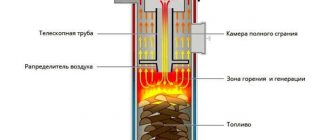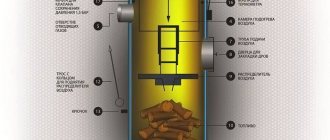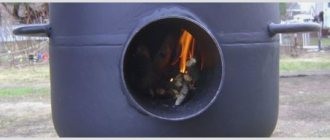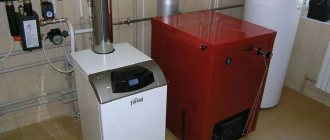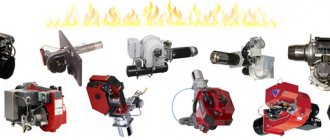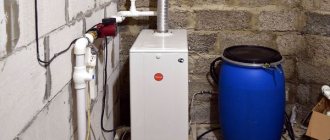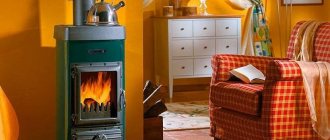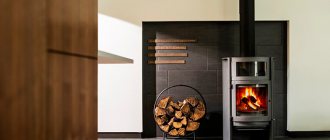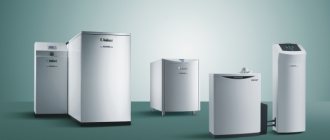Top-burning solid fuel boilers ensure long-term combustion of the burned raw materials due to the fact that there is no circulation of air and gases in the lower part of the firebox:
- On top, firewood, coal, pellets or other material used is covered with an air distributor, which rises when loaded. Thus, burning wood in a top-burning boiler lies in an area with a small amount of air, due to which flammable pyrolysis gases are generated.
- In this case, the flame flows around the disk covering the fuel and breaks out beyond its edges into the space between the distributor and the walls of the boiler, where flammable substances from the gases are burned.
- The flue waste then flows between the walls of the boiler and the cylindrical air heating chamber and is removed through the chimney.
Raw materials for top combustion boilers
Solid fuel boilers with top loading, long burning burn for a long time due to pyrolysis, that is, decomposition and partial gasification of organic fuel when heated. For productive work, you need to use organic raw materials with a high yield of volatile substances: firewood, wood products and waste, brown coal. Now on the market there are long-burning top-burning boilers that allow you to burn coke and coal.
Due to the lack of air required for open combustion, but sufficient temperature to maintain a flame, the embedded material chars and releases a flammable volatile mixture of carbon monoxide, hydrocarbons, nitrogen, hydrogen and primary air. Thus, the volatile mixture of combustion products does not escape into the atmosphere, but decomposes into burning components, releasing additional thermal energy.
It is recommended to use coarse fuel, which in practice burns not only from above. In addition, its humidity should not exceed 25-30%.
Bottom-burning boilers with top loading also use pyrolysis to increase efficiency, but their fuel is placed on a grate and burns from below.
Design features of solid fuel boilers with top loading
The combustion compartment of such units is designed so that the combustion process occurs from top to bottom. This is facilitated by the organized supply of oxygen. This method is more reminiscent of smoldering, in which gases are produced from raw materials containing carbon. Thanks to their burnout in the upper zone of the combustion chamber, maximum use of the generated energy is observed, which increases heat transfer and reduces the cost of purchasing firewood, briquettes, etc.
The devices are cyclical, and until the initial fuel supply is used up, there is no need to add additional raw materials.
Operating principle
There are a lot of designs of similar devices, but not all of them work on the same principle. Heat begins to form not through open combustion, but due to pyrolysis. Under the influence of high temperatures, the fuel only smolders and releases flammable gas. They begin to ignite and burn, resulting in a lot of heat being released. The slow process occurs by adjusting the oxygen supply. When the fuel begins to flare up, air flow is reduced to a minimum.
Thus, it will not be possible to use an ordinary Russian stove, as this will only lead to dire consequences. Gases can enter the room, and this can lead to poisoning. The oven with long-term heating is equipped with a sealed door, an adjustment device, and a damper, and this prevents gas from entering the room.
Heating devices of this type should be chosen because:
- They can work from one laying for 12-20 hours.
- Light weight structure, can be installed even without a foundation.
- Any fuel will do, burns completely, efficiency is 90%.
- Cannot be used on an ongoing basis.
- There are no foreign odors such as smoke.
- You can make it yourself from inexpensive materials.
- Low cost.
Regarding the last point - if you make a long-burning stove with your own hands, it will cost even less.
Equipment Specifications
Manufacturers produce boilers with different capacities, mainly 8-95 kW. However, some models reach higher values. There are even devices over 1000 kW. Moreover, the efficiency of the device and the heated area depend on the power. For example, units with minimal performance are used in small country houses and dachas.
The average efficiency of such boilers is in the range of 85-93%. However, there are models on the market with lower performance. According to the manufacturers, the operating time of the unit after laying firewood is 10-30 hours; on hard coal, the devices can operate for up to 3-5 days. In the first case, the heating temperature of the liquid reaches +70°C, in the second – +85°C.
The heating system itself can be either forced or natural circulation.
Operating principle of top combustion boilers
Long-term operation of the devices is achieved thanks to a large fuel tank and a 2-stage combustion method.
Design of a long-burning boiler with top loading of fuel.
The operating principle of the units is as follows:
- Firewood, coal or others are loaded into the compartment. Moreover, the tank itself is filled to the top. There is only a small space left for wood chips and branches for lighting.
- Using paper or a torch, set the bookmark on fire.
Since enough oxygen enters the compartment, active combustion begins. Gradually, when the fuel is completely engulfed in flames, air access into the chamber decreases. This process leads to slow smoldering of the raw materials, and subsequently to the combustion of the released gases. The fuel itself is processed into ash.
The efficiency of solid fuel units is achieved through maximum use of raw materials and heat generated in the process.
At the beginning of the gas combustion compartment there is a draft regulator. It automatically determines the temperature of the liquid and normalizes the combustion rate of volatile components.
The main principle of control of such devices is the regulation of air entering the chamber. The thermostat is adjusted to the required coolant temperature. And when the liquid heats up to the desired level, the damper is set to a different position, reducing the intensity of smoldering.
It is impossible to sharply increase the temperature unless the boiler is equipped with special fans for pumping air. In this case, the combustion intensity increases intensively, but more fuel is burned.
DIY oven
What else will you need besides a metal barrel?
- Sheets of iron 4-5 mm thick.
- Pipe with a diameter of 100 mm.
- A grate is better prepared, although you can make it yourself, for example, from a corner and wire.
- Asbestos cord.
Barrel construction
Now the sequence of assembly work:
The lid of the barrel is cut out with an allowance of 40-50 mm. A hole is made in the center of it, slightly larger than the diameter of the pipe 100 mm. A rectangular hole is cut out at the bottom of the barrel for the firebox. Fuel will be loaded through it. A smaller rectangular hole is made just below for the blower. From the inside of the barrel, between the firebox and the ash pit, wire guides are welded onto which the grate will be laid. A hole for the chimney is cut in the upper part on the side. A pipe with a diameter of 100 mm and a length of 20-40 cm is immediately welded to it. Now a pancake with a diameter slightly less than the diameter of the barrel is cut out of a metal sheet. A hole is made in the center of the pancake and a pipe with a diameter of 100 mm is welded to it. The length of the pipe should be 20-50 cm greater than the height of the barrel. Rectangles 50-80 mm wide are cut out of the same sheet, but their length should be equal to the distance from the edge of the pancake to the edge of the through hole in the center. These pieces are evenly welded in a circle with an edge on the back side of the welded pipe. This node is called a press. With its help, the fuel will be pressed down so as not to create a large space for the combustion zone. Now we need to carry out partial assembly. That is, a grate is installed and a press is lowered from above. A lid is placed on it so that the press pipe fits into the hole in the lid. Now the lid is welded to the stove body around the entire perimeter
Here it is important to weld the seam very tightly. An asbestos cord must be placed in the gap between the protruding pipe and the hole in the lid; it will become a barrier to smoke and carbon monoxide. The door is hung on the opening of the firebox. The gate is installed on the blower.
Everything is ready, all that remains is to install the stove at its destination and attach the chimney to it
Under such a unit, a strong and fire-resistant base must be poured, this is important
Fuel loading
Now to the question, how to add fuel? For this you will definitely need an assistant. He will lift the press by the protruding pipe. You need to lift it as high as possible to completely open the combustion chamber. The fuel is packed tightly with minimal space between its parts. The less air inside the firebox, the longer the pyrolysis process takes.
Not everyone probably understood why the pipe that was welded to the press was needed. This is a special channel through which fresh air will be supplied to the fuel combustion zone. And the ribs welded at the bottom will create the necessary space for air to penetrate inside, plus they add additional weight to the press.
This is one of the models of long-burning stoves that you can make with your own hands from a two-hundred-liter metal barrel. Let's face it, the option is not the most difficult, but not the most beautiful either. No one will install a barrel in a living space, so such stoves are most often installed in utility rooms for office purposes. For example, in garages, workshops, greenhouses, and so on. Although some summer residents install them inside the main building, enriching the structure with additional elements. For example, you can install a decorative screen in front of the stove, or line it with brick. Anyone who wants to will find options to make the stove beautiful.
Scope of application of top-loading boilers
The devices are used primarily for heating industrial and warehouse premises. They can often be used in country cottages, since, unlike gas equipment, they do not require special permits - just a suitable location and compliance with fire safety rules.
The scope of application of top-loading boilers is heating of industrial premises.
Advantages of TT boilers of this type
The advantages of solid fuel devices include the following:
- long operating time without the need for frequent addition of raw materials;
- energy independence due to natural draft (except for equipment with forced air circulation);
- versatility, since you can use different types of fuel - coal, briquettes, firewood, etc.;
- high efficiency and heat transfer;
- simple installation and subsequent operation, because there are no complex mechanisms (for this reason, repairs to the structure require lower costs);
- average service life more than 10-15 years;
- convenience and time saving (unlike units with front loading).
Disadvantages of top loading fuel
Such devices, according to user reviews, also have some disadvantages:
- increased formation of ash and soot, which is why you have to periodically clean the chamber, ash pan and chimney (otherwise heat transfer will decrease);
- gradual oxidation of metal parts;
- impossibility of storing bulky fuel (for example, uncut firewood);
- increased sensitivity of the device to draft, therefore, when installing a chimney, a high-quality calculation is required (it is better to invite a specialist);
- formation of resin on the partitions of the internal chamber (in the case of using damp fuel).
Increased formation of ash and soot is a disadvantage of boilers.
In addition, it is impossible to reload raw materials after ignition. You need to wait for the process to finish.
Some owners note that the partition of the unit, located between the areas of fuel combustion and gas emission, quickly breaks down and requires replacement.
When operating boilers, careful placement of raw materials is also necessary. If you simply add fuel to the tank of top-loading equipment, the efficiency will decrease. It also often happens that the log gets stuck (hangs) between the walls in the combustion compartment, and further smoldering stops (you have to re-ignite the unit).
Fuel requirements for boilers
Briquettes, coal, firewood, etc. can be used as fuel for equipment, since the devices are universal. When choosing raw materials, the combustion time in the boiler should be taken into account. For example, with a single addition of firewood, the unit can operate for 30 hours, and with the use of pellets, the period increases to 72. If you use hard coal, many models can operate even up to 5 days. However, the time also depends on the volume of the tank itself.
When purchasing firewood, you need to make sure that it is dried, or arrange in advance a special place for storing it with good ventilation. Coal is considered the best option, since it provides maximum heat transfer. Anthracite has high performance, but the cost of such fuel is higher.
Charcoal has normal heat transfer (preferably hard varieties). If you use a cheaper (brown) analogue, the amount of ash increases.
Briquettes and coal can be used as fuel.
Scope of application – both in the garage and in the house
How can I use a long-burning stove? The choice of design and model will depend on the tasks facing the unit. If you need it for your dacha or home, it is better to use a stove with a water jacket, which will combine water and stove heating. the water will help distribute thermal energy throughout the system and heat the room, while at the same time the housing will warm up, which will increase the efficiency of heat transfer.
In a boiler that has been heated for a long time, when turned off, the water will quickly cool down and the water will become cold, but the stove will cool down slowly and give off a little heat. For a dacha, it is preferable to have such a stove rather than solid fuel boilers. It has a coil in which the water will be heated, and sometimes it needs to be installed directly into the firebox, and this is unsafe. The high temperature resulting from the combustion of gas can cause the water to boil and destroy the coil.
It is better to install a heating coil on water in the chimney cap. This solution is ideal for heating cottages and will increase heat transfer. The design of the device is chosen taking into account the area of application, and for a small garage, bathhouse and greenhouse it can be used without a water circuit. A stove that heats the air is convenient because the intensity of combustion can be adjusted. It perfectly warms small rooms, which is ideal for baths, but is not suitable for a house where the owners live all year round.
What to look for when choosing
Owners of country houses or warehouses should take into account certain aspects when purchasing equipment. The efficiency of their operation and the ability to heat a given area depend on the characteristics of the devices.
Heat exchanger material
In most cases, manufacturers supply steel and cast iron devices. However, there are models with copper heat exchangers on the market.
Each option has its advantages and disadvantages:
- Steel. The most common heat exchanger material. It has low cost and light weight. Steel elements are characterized by inertness to elevated temperatures due to the plasticity of the metal, therefore, deformation of parts during strong heating is eliminated. However, the exposure of steel to corrosion and chemical compounds leads to the fragility of the heat exchanger. The efficiency of such models is mostly low; the water quickly cools down after the raw material has died down.
- Cast iron. The products are heavy, so they are used only in floor-standing units. Resistant to aggressive influences and characterized by increased heat transfer. Despite the longer heating of the liquid, the water does not cool down after the raw material has died down for a long time. However, it is impossible to carry out a quick repair, since it is difficult to solder the cracks, and if the cast iron cracks, you have to buy a new part.
- Copper. A heat exchanger made of such material is considered the best option. It has good heat dissipation, high corrosion resistance and durability. The disadvantages are the high cost and small selection of equipment.
Efficiency
The efficiency is determined based on the selected fuel, the characteristics of the system itself and additional aspects (for example, ventilation, etc.). Moreover, the higher the indicator, the better. For example, with an efficiency of 80%, 20% of the energy is lost. In pellet devices, the efficiency reaches 95%, so such devices operate with maximum heat transfer.
The efficiency of pellet appliances reaches 95%.
Number of circuits
The device is selected depending on the purpose. For example, for heating only it is enough to purchase a 1-circuit model. If the owner also requires hot water supply, he will additionally have to buy equipment - a special tank - or immediately purchase a 2-circuit boiler.
Energy dependence
The uninterrupted operation of the equipment depends on this criterion. In rural areas, power outages are common. And if the device operates from the network (for example, there is a fan, pump, etc.), you will have to buy a generator. In non-volatile models such problems are eliminated.
Load volume
The indicator directly affects the frequency of fuel loading. The larger the load volume, the longer the equipment will operate. There are devices with automatic loading on the market, but they depend on a stable supply of electricity and are more expensive.
The loading volume affects the frequency of fuel loading.
Power
The parameter is selected depending on the area of the room and the required water temperature.
There are devices on the market with different meanings. Therefore, you need to buy a model taking into account many aspects, including climatic conditions and region of residence.
Rules for safe operation
To ensure that the operation of heating devices does not cause any trouble, you should follow a few simple rules for their use:
The stoves must be installed on a non-flammable, heat-resistant base made of concrete or asbestos-cement sheets with a sheet of iron laid on them. The elements of the heating device must be in good working order: the legs must firmly hold the stove, the door lock is working, and the grates are intact. Do not load the firebox more than 2/3 of its volume, or install it less than 80 cm from walls or flammable partitions. Particular attention should be paid to chimneys; all joints should be sealed with special tape. Do not leave flammable objects, plastic products, network carriers, or children's toys near the stoves. There is no need to leave heavy objects, such as a bucket of water, on the stove for a long time. Do not open the door when fully loaded with fuel.
In addition, experts advise using only well-dried firewood. By following these simple rules, you will protect yourself and your home from possible troubles.
Wood-burning stoves for heating have a variety of designs and designs, from which it is not easy to choose the right one, suitable not only for the interior of the room
Sources
- https://expert-dacha.pro/otoplenie/pechi/pechi-kaminy/dlya-dachi-dlitelnogo-goreniya.html
- https://TehnoExpert.top/drovyanaya-pech-dlya-doma-reyting
- https://almaz2000.ru/for-clients/articles/reyting-pechey-dlitel-nogo-goreniya/
- https://HouseChief.ru/kak-vybrat-pech-dlya-dachi.html
- https://sovet-ingenera.com/otoplenie/pechi/otopitelnye-pechi-na-drovax-dlya-dachi.html
The best models of top combustion TT boilers
Each manufacturer indicates only positive aspects in the product characteristics. According to consumer reviews, there are better boiler models that have performed well during operation.
Stropuva S-15U
The boiler is a compact device made in Lithuania. With a power of 15 kW, the unit is capable of heating a room with an area of 120-130 sq.m. The device runs on any solid fuel and is easy to maintain.
Stropuva S-15U is a Lithuanian-made device.
The boiler is equipped with a 217 liter compartment for storing raw materials. Using coal, the device can operate on a single load for up to 5 days with an efficiency of 86-90%, heating water to 75°C.
The weight of the unit is 205 kg, the average cost is 90-92 thousand rubles.
Liepsnele L20 U
The model of the Lithuanian manufacturer has a power of 20 kW and is installed to heat rooms with an area of 150-180 sq.m. The boiler is equipped with a combustion compartment with a capacity of 320 liters. The maximum achieved efficiency is 91%. Thanks to the cast iron heat exchanger, heat is retained even after the firewood or briquette has died out. The water temperature reaches 80°C.
Due to the low operating pressure (about 1.5 bar), the equipment can only be used in systems with natural fluid movement. The average cost of the device is 108-110 thousand rubles.
Stimulus DG-1 20
The model of the Russian manufacturer is equipped with a combustion compartment of 110 liters. The device, with a power of 20 kW, is capable of heating a room up to 170 sq.m., and any type of solid fuel can be used. The average price of equipment is 95-97 thousand rubles.
“Stimul DG-1 20” is equipped with a combustion compartment.
"Lemax" Forward-20
The manufacturer of this energy-independent unit is Russia. The device is equipped with a steel heat exchanger. The weight of the equipment is 78 kg. With a power of 20 kW, a 1-circuit boiler is capable of heating a room of up to 150 sq.m. The efficiency of the device is 72-77%. The average price of the device is 27-28 thousand rubles.
Galmet Top
The Polish-made pyrolysis boiler has a power of 20 kW and is designed to heat a house with an area of up to 180 sq.m. The device is equipped with a PID controller, a recirculation pump, an electric fan and independently selects the desired heat transfer mode depending on the air temperature.
Galmet Top has a power of 20 kW.
The maximum efficiency of a 2-circuit unit, even when burning coal, reaches only 87%. The device is equipped with a steel heat exchanger. The average price of equipment is 88-90 thousand rubles.
Dakon DOR F-27
The Czech-made model has a power of 27 kW and is intended for heating rooms with an area of 230-250 sq.m. The non-volatile unit is equipped with a steel heat exchanger and a durable metal housing. The package includes a thermometer and pressure gauge. The maximum efficiency indicator for the equipment is 78%. The average cost of a boiler with vertical fuel loading is 87-89 thousand rubles.
"Week" KO-60
The unit is equipped with a 160-liter compartment for loading raw materials. With a power of 60 kW, the device is capable of heating air in rooms with an area of 350-400 sq.m. The maximum efficiency of 92% is achieved when burning pellets. The boiler with top fuel loading includes a remote control panel and a WPA X2 fan, which promotes high-quality oxygen supply.
The Nedelka KO-60 boiler is equipped with a 160-liter compartment.
The heat exchanger and body of the device are made of thick stainless steel, which increases the service life of the equipment, but the weight of the unit is 420 kg. The average price of a boiler is 130-135 thousand rubles.
"Universal" TA 40
A 40 kW device produced by the Kostroma plant is supplied to the market with 2 circuits, i.e. capable of heating rooms up to 300 sq.m. and at the same time providing owners with hot water supply. This is a universal model, so it works on any type of solid fuel. The maximum efficiency of the equipment is 85%. Thanks to the software, the boiler can maintain the set temperature throughout the day. The average price of the unit is 102-104 thousand rubles.
Price
Prices for pyrolysis boilers are quite high. Here, buyers need to compare the characteristics of this equipment in terms of power and manufacturing class.
It may turn out that a pyrolysis boiler will cost a couple of times more than a classic product of the same type.
- A manufacturer may offer a long-term combustion pyrolysis furnace for 150 thousand rubles, but a boiler of the same power, but of a classic type, will cost the customer 50 thousand rubles.
- The same can happen with foreign-made and Russian-made devices, where the cost may differ by either 75 thousand rubles or 35 thousand rubles.
Therefore, before purchasing, it is very important to compare prices for pyrolysis boilers from different companies. It may turn out that there is no need to overpay for a device of the same power and functionality.
Advice! You can make a pyrolysis boiler yourself. The material listed below is used for this.
Reviews of solid fuel boilers with top loading fuel
Ilya Shchegortsov, 35 years old, Nizhny Novgorod:
“I purchased a Dakon DOR F27 device for my country house. The unit copes well with heating rooms and even the basement, although the total area is about 260 sq.m. During operation, the boiler does not make much noise and works properly. The required temperature and pressure indicators can be viewed on the corresponding sensors.”
Denis Skvortsov, 28 years old, St. Petersburg:
“For my dacha, I purchased a Liepsnele L20 U boiler from a Polish manufacturer, although during the review I saw many models with a similar combustion principle. The unit copes with its functions, and is practically silent during operation. I bought the device mainly because of the large combustion compartment with a capacity of 320 liters, which is convenient when going to the city for groceries - it definitely won’t go out.”
Dmitry Rastorguev, 55 years old, Moscow:
“Since I constantly live in a country cottage with an area of 400 sq.m., I had to buy the appropriate equipment. I think the best choice is the “Nedelka” KO-60 model. The device has good heat dissipation and power. Although it makes a little noise during operation, I do not consider this a disadvantage - the equipment is located in the basement, and there are no problems. And thanks to the remote control, managing the required temperature indicators is as convenient as possible.”
